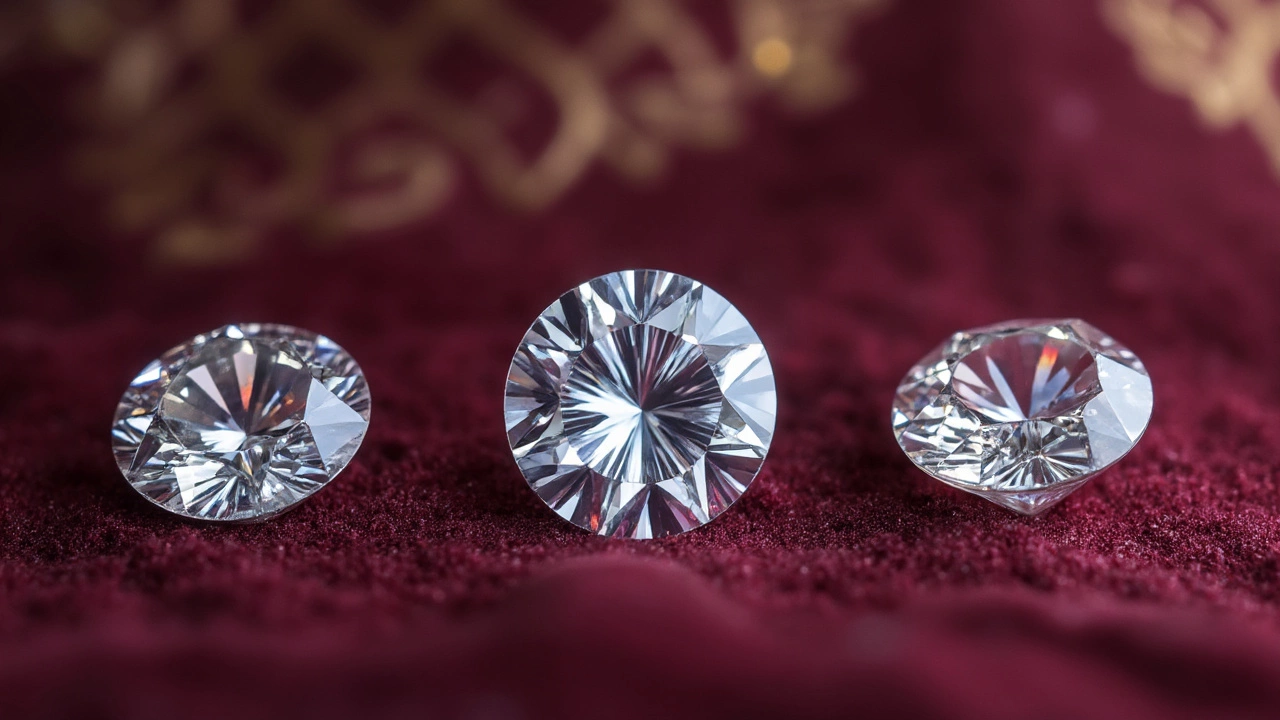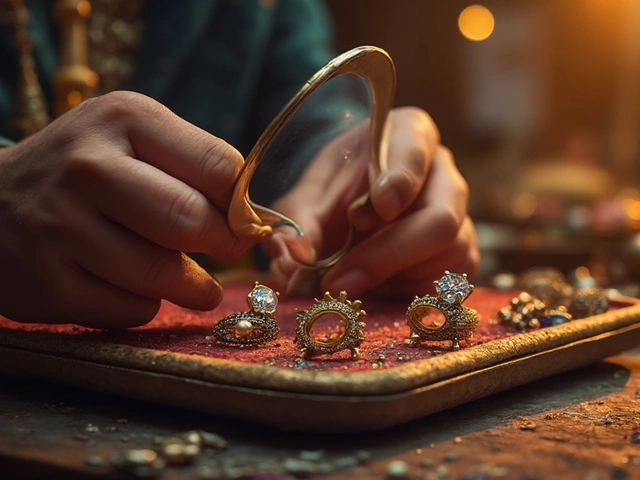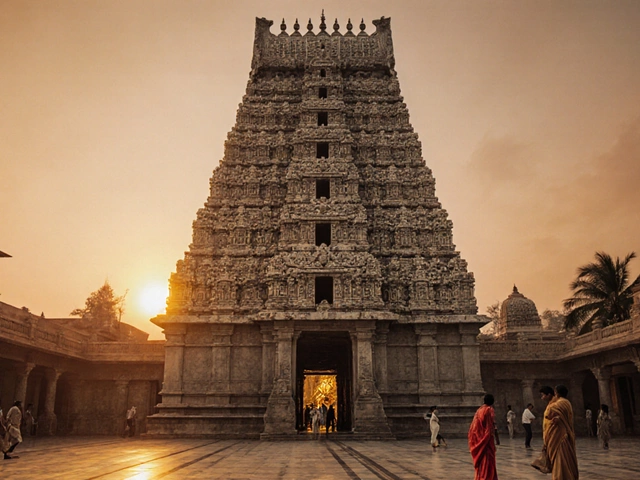
If you type ‘cheap diamond’ into Google, you’ll find more questions than answers. In the jewelry world, there isn’t an official stone called a ‘cheap diamond,’ but there are diamonds—and diamond lookalikes—that go for way less than the classic, flawless mined gem. So what do people in India (and everywhere else) actually call them? The most common names you’ll see are ‘lab-grown diamond,’ ‘clarity enhanced diamond,’ and sometimes even ‘simulant’ if it isn’t a diamond at all.
It’s easy to get confused when everyone throws buzzwords around. Sellers might say ‘affordable diamond’ or ‘budget diamond’ to make things sound fancier. But if you’re shopping for an engagement ring or looking for a gift that won’t wreck your bank account, you’ll want to know the honest terms. Each label tells you something real about what you’re getting—so paying attention will save you money and headaches.
- What Exactly Is a 'Cheap Diamond'?
- Lab-Grown Diamonds: The Popular Pick
- Clarity Enhanced and Treated Diamonds
- Alternative Stones That Look Like Diamonds
- Should You Buy a Cheap Diamond?
What Exactly Is a 'Cheap Diamond'?
You might hear folks talk about ‘cheap diamonds,’ but that’s not some secret diamond type. In the gemstone world, a cheap diamond just means a diamond—or sometimes a diamond substitute—that costs way less than the usual stuff you see flashed in Instagram reels. These could be real diamonds that have “issues” (like low clarity or color), stones that are made in a lab, or even good fakes.
Here’s the deal: Some diamonds are cheap because they’re small, super-included, or oddly colored. Others are cut in a way that doesn’t show much sparkle. Then there are diamonds that were once pretty meh, but got a color or clarity treatment to look better. Of course, there’s also a whole category of non-diamond stones, like cubic zirconia, which are basically just pretending to be diamonds. But for the sake of this article, we’re talking about real diamonds that are simply affordable—or cheap diamond options.
“People often get confused between real but affordable diamonds and diamond simulants. A cheap diamond is still a diamond—just one that’s more budget-friendly due to clarity, size, color, or being grown in a lab,” said Rajesh Jain, CEO of a top Mumbai jewelry export company.
According to Indian gem traders, most under-₹30,000 diamond rings get classified as ‘affordable’—but prices vary big time depending on the diamond’s background story. Check out this quick breakdown of budget-friendly diamond types you might run into:
- Lab-Grown Diamonds: Real diamonds, just made in a lab instead of underground.
- Clarity Enhanced Diamonds: These have natural flaws that get treated to look cleaner.
- Low-Grade Natural Diamonds: Still natural, but less shiny or clear—think more ‘character’ than ‘bling’.
- Diamond Simulants: Not actual diamonds, but look similar (like moissanite or CZ).
If you want real numbers, here’s how pricing typically stacks up:
| Type | Average Cost per Carat (INR) | Notes |
|---|---|---|
| Lab-Grown Diamond | ₹60,000 - ₹1,20,000 | Up to 50% cheaper than mined |
| Clarity Enhanced Natural Diamond | ₹80,000 - ₹1,50,000 | Cheaper than untreated stones |
| Low-Grade Natural Diamond | ₹50,000 - ₹2,00,000 | Wide price range (depends on flaws) |
| Cubic Zirconia | ₹200 - ₹500 | Not a diamond, but looks close |
So, next time someone offers you a ‘cheap diamond,’ ask which kind it is. That’s your best step to making sure you’re getting what you actually want, not just a good sales pitch.
Lab-Grown Diamonds: The Popular Pick
If you've been hearing everyone rave about budget-friendly diamonds lately, they're probably talking about lab-grown diamonds. These are real diamonds, not fakes. They’re made in high-tech labs using machines that copy what happens deep underground. Nobody can tell the difference by just looking because the chemical and physical properties are the same as natural diamonds.
The biggest draw is price. Lab-grown diamonds usually cost 40% to 60% less than mined diamonds of similar size and quality. That means if a natural one-carat diamond costs ₹3 lakh, a lab-made one of the same specs could set you back around ₹1.5 to ₹1.8 lakh. Here's a quick comparison:
| Type | Average Price (1 Carat, India) | Source |
|---|---|---|
| Mined Diamond | ₹3,00,000 | Earth (mined) |
| Lab-Grown Diamond | ₹1,50,000 – ₹1,80,000 | Laboratory |
Besides price, there’s a growing crowd choosing lab diamonds for ethical reasons. Traditional mining can mess up the environment and involves tricky supply chains. With lab-grown, you skip those worries, making it a guilt-free buy for your cheap diamond hunt.
If you want to buy one, keep a couple of tips in mind:
- Lab-grown diamonds should always come with a grading certificate, just like natural ones. Look for certifications from IGI, GIA, or SGL.
- Not all jewelry shops in India stock lab-grown diamonds yet, but plenty of big players online do. Always check seller reviews before you shop.
- The resale value is lower than natural diamonds, so buy it for enjoyment, not investment.
The bottom line? If you want a sparkler that looks just as good but costs way less, lab-grown is definitely the hit of the moment.

Clarity Enhanced and Treated Diamonds
Heard the term 'clarity enhanced'? This basically means the diamond had its flaws fixed—kind of like getting a dent out of a scooter so nobody notices. Sometimes diamonds have little cracks or tiny spots (jewelers call them "inclusions"). Through clarity enhancement, companies fill in those cracks with special materials or use lasers to zap away dark bits. These tweaks make the diamond look way cleaner, but the process leaves tiny signs behind that trained eyes can spot.
The most common tricks are fracture filling and laser drilling. Fracture filling involves pumping a clear substance into the crack, making it almost disappear. Laser drilling, on the other hand, creates super-thin holes so spots can be bleached out. Either way, you get a shinier diamond for less money—which is why these are some of the top choices for a cheap diamond in India.
- Fracture filled diamonds are usually 30%–60% cheaper than untreated stones.
- Laser-drilled ones still cost less than comparable natural diamonds but keep more of their sparkle.
- Clarity enhancement doesn’t change the base quality of the diamond but it does up its appearance.
- Jewelry experts strongly recommend you always get full disclosure if a diamond was treated, especially if you’re making a big purchase.
Do these diamonds last? Mostly—if you’re careful. Avoid strong ultrasonic cleaners and harsh chemicals. Resizing a ring with a treated diamond might also be tricky since high heat can cause the filling to leak out or change color. Want an easy side-by-side? Check out the mini table below with key details:
| Type | How It's Treated | Estimated Price Cut | Care Level Needed |
|---|---|---|---|
| Fracture Filled | Injected with clear substance | 30-60% cheaper | High |
| Laser Drilled | Tiny holes bleached | 20-40% cheaper | Medium |
If you’re after something shiny on a tighter budget, treated diamonds offer a solid option. Just make sure the jeweler tells you up front about any treatments—no one likes hidden surprises when it comes time to upgrade, trade, or sell.
Alternative Stones That Look Like Diamonds
Not everyone hunting for a diamond ring actually buys a natural diamond. Whether you want to save cash or just get a bigger stone for the same price, there are plenty of options that look almost identical to the real thing at first glance. These are called diamond simulants—basically copycats when it comes to sparkle and style. Let’s break down the main ones smart shoppers in India usually check out:
- Cubic Zirconia (CZ): This synthetic stone tops the list for most popular diamond lookalikes. It can look pretty convincing, especially in a fresh setting. But here’s the catch: it’s much softer, so it scratches up and goes cloudy over time. A CZ ring that looks new today might look dull in a year if you wear it a lot.
- Moissanite: This stone is a favorite among folks who want a bit of extra flash. Moissanite outshines diamonds when it comes to brilliance (that rainbow sparkle in the light). It’s tougher than CZ, so it stays looking good longer. It’s more expensive than CZ but still much cheaper than a diamond.
- White Sapphire: Some people in India like going for sapphire instead because it’s a natural gem. White sapphires don’t quite sparkle like a diamond, but they’re real stones and tougher than you’d think. They don’t grab attention in low light, though.
- Synthetic Spinel: This one isn’t as common, but it pops up in budget jewelry all the time. It gives you a decent shine for a fraction of the price.
If you’re wondering how these compare, here’s a quick look at how they stack up against diamonds:
| Stone | Hardness (Mohs) | Price (per carat avg.) | Sparkle/Brilliance |
|---|---|---|---|
| Diamond | 10 | ₹50,000+ | Excellent |
| Cubic Zirconia | 8-8.5 | ₹200–₹1,000 | Good (fades with time) |
| Moissanite | 9.25 | ₹5,000–₹10,000 | Very high |
| White Sapphire | 9 | ₹2,000–₹6,000 | Fair |
| Synthetic Spinel | 8 | ₹500–₹2,000 | Moderate |
The important thing: If you really want the look of a cheap diamond but don’t want to spend on the real deal or on a lab diamond, these are your best bets. Just know what you’re getting. Moissanite, for example, might be mistaken for diamond but has a brighter, disco-ball effect under light. Cubic zirconia is tempting for price, but if you want something that lasts, moissanite or white sapphire are safer picks.
Before you pick, try to see the stone in person. The way a stone catches the light, its ‘fire’, and how it feels in a setting makes a bigger difference than you’d expect. And if a jeweler ever tells you a simulant is the same as a diamond, walk away—they’re not being straight with you.

Should You Buy a Cheap Diamond?
So, is snagging a cheap diamond actually worth it, or will you regret it when you open the box? It really comes down to what matters most to you—appearance, budget, or long-term value.
Let’s break down what you’re really getting when you buy a cheap diamond (think lab-grown or clarity enhanced):
- Lab-grown diamonds look almost identical to natural diamonds. Even jewelers use special testers to tell the difference. There’s no mining, which is better for the planet and usually for your wallet—they can cost 30-50% less than natural stones with the same specs.
- Clarity enhanced diamonds start as real mined diamonds but get a boost by filling cracks or using laser treatment. They look cleaner but might not be as durable in the long run. Expect to pay about 20-40% less than untreated diamonds, but keep in mind possible repairs down the line.
- Simulants (like cubic zirconia or moissanite) aren’t diamonds at all, but they still sparkle. They cost a fraction of the price—a moissanite ring, for example, can look brilliant for less than a tenth of the cost of a mined diamond.
Here's a quick cost comparison by type for a 1-carat stone, just to put it all into perspective:
| Type | Average Price (1 Carat, INR) | Durability |
|---|---|---|
| Natural Mined Diamond | ₹3,50,000+ | Excellent |
| Lab-Grown Diamond | ₹1,50,000–₹2,00,000 | Excellent |
| Clarity Enhanced Diamond | ₹2,00,000–₹2,50,000 | Good (may need care) |
| Moissanite | ₹50,000–₹80,000 | Very Good |
| Cubic Zirconia | ₹3,000–₹7,000 | Fair (scratches/chips easier) |
If you’re not worried about resale value and you just want a ring that looks amazing, lab-grown or simulant stones make a ton of sense. But, if you think about passing it down to your kids—like I’d want to give Eamon—you might want something that holds its value, like a natural diamond. Pieces with treatments or non-diamond stones tend to drop in price quickly if you ever try to sell or trade them.
Tips before swiping your card:
- Always ask for lab or treatment certificates.
- Compare stones side by side in real light, not under the super-bright store LEDs.
- If you’re buying online in India, stick to brands with physical stores and a return policy.
- Read reviews—some enhancement treatments can cloud after years, especially if the ring gets wet often.
Bottom line: picking the right diamond isn’t about what you spend, but getting what matches your priorities. There’s no shame in saving big if you do your homework.




